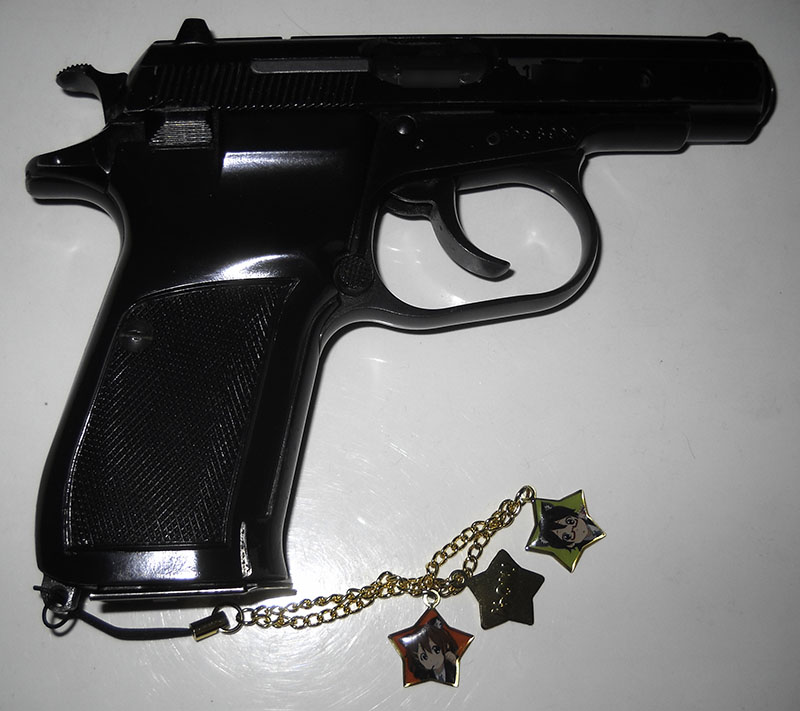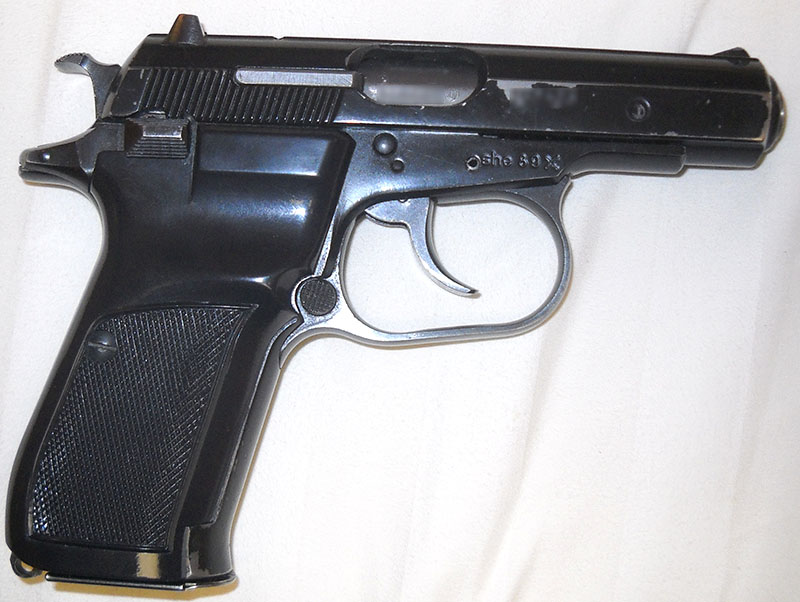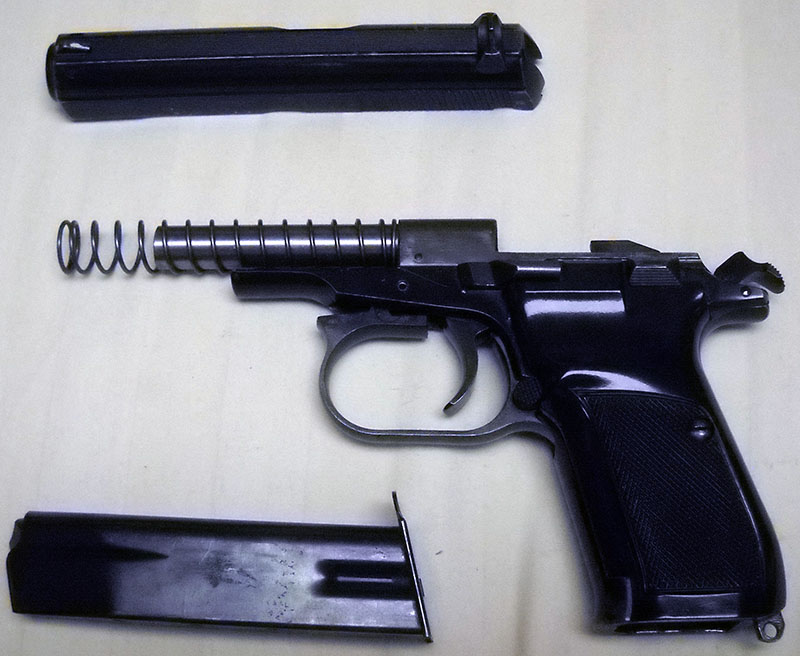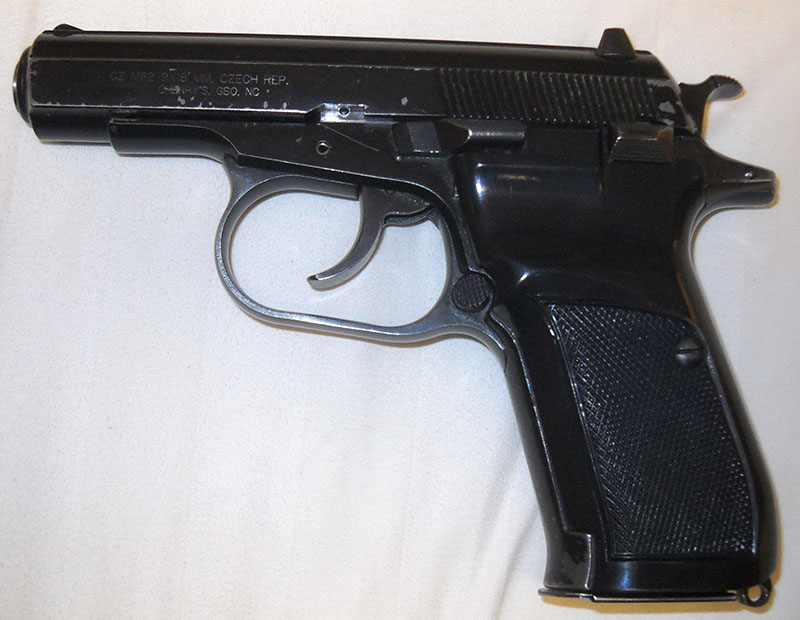

Originally posted December 18, 2015 and December 28, 2015
I got bored one night and did a little culturejamming, when I noticed that, unlike the big swiveling ring mounts you find on older military handguns (like, for instance, the Nagant), my CZ 82 just has a little fixed lanyard loop on it, not unlike the ones you used to find on cellphones. (Maybe they're still a thing on other phone models, but there's never been one on a Motorola Droid that I know of, so I haven't had one on a phone of mine for at least five years now.)
So, well, I had this Czech military handgun with a cellphone-like lanyard loop, and I had a couple of Japanese anime-themed cellphone straps that I've never been able to use because my phone doesn't have anywhere to mount them.
You can probably guess what happened next.

Yup.
The CZ 82 is an interesting item. Let's take a closer look:

Here we have a CZ vz. 82, or more formally a Ceská Zbrojovka Model 82 pistol. "Ceská Zbrojovka" is Czech for "Czech Arms Factory" and may refer to any one of a number of (in some cases formerly-)state-owned arsenals in the Czech Republic. The most famous in the West is the one in the town of Uherský Brod, since it's where some of the Czech small-arms industry's best-known exports are made; since 1992, CZUB has been a private company, but well before then it was well-known among Western handgun enthusiasts as the Czech state arsenal where the CZ 75 pistol was made.
The vz. (an abbreviation of the Czech word for "model") 82 was manufactured strictly as a military sidearm, not for consumer sale or export; the ones that are available on the open market now are military surplus sell-offs. Technically, therefore, there is no such thing as a "CZ 82" (though the export version, almost identical mechanically but with different cosmetics, was the CZ 83), but it's a convenient shorthand to convey the manufacturer and model, so let's go with it.
After World War II, when Czechoslovakia (which had been dismantled by Nazi Germany with the shameful connivance of the Western powers in 1938) was reconstituted as a Soviet satellite state, their arms industry did things a little differently than things were done in, e.g., Romania or East Germany. In those parts of the Eastern Bloc, state armories made copies of stuff developed at Soviet arsenals, so that the Red Army's "fraternal socialist allies" would have standard equipment commonality with them. In Czechoslovakia, which was the westernmost of the Warsaw Pact members and which had a well-deserved reputation for technical and industrial excellence before the war, they wanted no part of that. Besides, they didn't figure they would be able to export much Soviet-designed stuff to the West for hard currency, unlike their own products.
So, particularly in the realm of small arms, they kept to their own standards and design practices. They standardized ammunition with the Soviets, but the Czechoslovak armies carried different weapons to use it. The CZ 82 was one of those. It was developed in 1982 to replace the postwar CZ 52 (which, like the 82, is really the "vz. 52", but is even more commonly called the CZ 52 because there was also a vz. 52 rifle that had nothing to do with it). The CZ 52 used the Soviet 7.65×25mm Tokarev cartridge, the same as the Soviets' standard-issue TT-33 pistol, and the 82 uses its replacement, the 9×18mm Makarov. (The CZ 83 export version was also available in .32 and .380 ACP, the idea being that 9mm Makarov ammunition was not commonly available in the West at the time. Nowadays, of course, it's easy to get hold of, but at the height of the Cold War, not so much.)
9mm Makarov is a slightly strange animal. Its case length falls squarely between two common Western handgun cartridges, 9x19mm Parabellum (also known as 9mm Luger) and .380 ACP (also known as 9×17mm Browning Short), and its ballistic properties likewise split the difference. There was, as far as I can tell, no real reason for the Soviets to do that, other than to make certain that neither decadent Western cartridge would work in their guns and vice versa. It wasn't as though there were enforceable patents on either cartridge by the 1950s, when 9mm Makarov first appeared, even if the USSR historically gave a shit about Western patents. But anyway. I had a Romanian Makarov clone for a while, years ago, and found it distinctly unpleasant to shoot. The CZ 82's superior Czech grip ergonomics help a lot, but it's still a bitey little cartridge. Recoil is not particularly strong, but it is quite sharp, somehow. Something to do with the pressure curve of the cartridge, I suspect.
At any rate, there's the CZ 82. Mechanically, it's kind of a riff on the Walther PP series; so was the Makarov, but the Czechs did it in a slightly different way. Most notably, they improved the PP's takedown mechanism, which involves pulling the trigger guard down to unlock the barrel-slide assembly so it can be removed. On the PP (and the Makarov), you have to hold the trigger guard down and work the slide first back and up, then forward and off, which is one of those pistol takedowns that kind of need three hands. The CZ 82's unlocks and stays that way until you lock it again. Much friendlier. It has the same blowback system where the barrel is fixed to the frame, which is more inherently accurate than a rotating or tilting barrel lockup system, but the 9x18mm cartridge is just on the borderline of too powerful for that kind of system to work safely. It therefore requires a pretty heavy recoil spring, which is my one beef with the gun from an operator's perspective; working the slide is harder than it seems like it should be in a pistol this size, because of that beefy spring the blowback system requires. (I'd be interested to see if the less powerful .32 and .380 CZ 83s are set up with more manageable springs.)

Beyond that, there's not a lot more to tell apart from some history. in 1993, after the end of the Cold War, Czechoslovakia split into the Czech Republic and Slovakia; the Czech and Slovak armies both kept the CZ 82 as their standard sidearm. (A bit oddly, Wikipedia claims that the Vietnamese Army also uses them, as do—randomly—cops in Israel.) Recently the Czechs have started phasing them out in favor of a new version of the larger, more powerful 9x19mm CZ 75 (essentially a revised copy of the Browning Hi-Power, and an interesting weapon in its own right, though I don't have one as they are quite expensive). This meant that a lot of ex-Czech Army CZ 82s suddenly appeared on the surplus market. This is one of those.

The finish on these ex-military pistols is rather interesting; you can see from the way it's worn in the photos that it isn't blued (a process of controlled corrosion) like most vintage and many modern firearms, nor does it have a phosphate coating like Western military hardware (usually called "Parkerizing", though that's the trade name for only one of a range of similar treatments). It's actually painted with some kind of enamel paint, probably baked on at the factory, like car paint, and over time it's chipped off at the corners and wear points. This is especially noticeable on the photo of the right side, in front of the ejection port, right where I've blurred out the serial number.
When they were surplused out of the Czech Army, these were bought up and brought into the US by a number of different importers. As noted elsewhere, I used to have one that was imported by Century Arms, whose federally compliant import markings were at the time kind of embarrassingly primitive. Interestingly, the one I have now, although only a few thousand serial numbers away from my old one, came in via a different importer:

I think this was also done with a dot matrix engraver, but it's a bit more professional-looking than the early Century efforts, though it's not very deep and you can see where it's already starting to wear off at one end. Again, all the relevant information is here, though the importer's location verges on overly cryptic. Unless you live somewhere in the area and it's a common local abbreviation, you'd probably have to google it (like I did) to find that GSO is short for Greensboro. It appears that this particular CZ 82 was imported by Cherry's Fine Guns, whose extremely 1998-retro website claims they are The World's Leading Commemorative Gun Dealer. Interestingly, it appears they offer import services, whereby if you want some foreign guns brought into the US, they'll handle the ATF paperwork and engraving for you. It may be that this particular CZ was brought in under that kind of small-scale import deal, rather than in a containerload batch like Century usually deals in.
These are nifty little guns; that enamel finish is a bit weird, but the build quality is excellent, as expected from the Czech small-arms industry, and they have that interesting different-drummer-Communism thing about their background.
Also interesting: The vz. 82, dating from you guessed it 1982, is one of the most recently produced firearms I could find on the U.S. Bureau of Alcohol, Tobacco, Firearms, and Explosives "curio and relic" list, most of which dates to at least 1960. (Technically anything more than 50 years old is a C&R item—which, as Ian recently noted in a Forgotten Weapons video, means the earliest-production AR-15s now qualify, weird as that is to consider—but special dispensations can be made for things that are newer than that, if they can be shown to have primarily collector or curiosity value. One wonders who asked the ATF for such a dispensation for the vz. 82, and why they decided to grant it.)
--G.